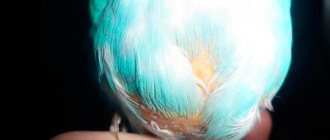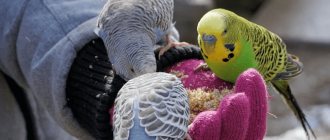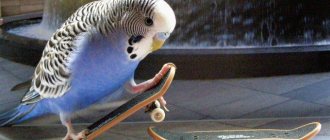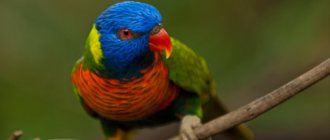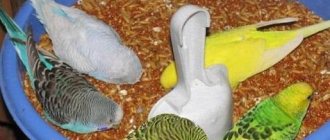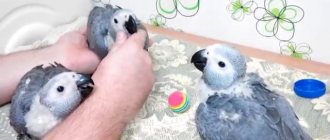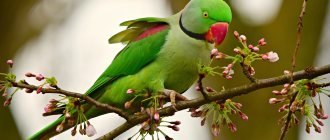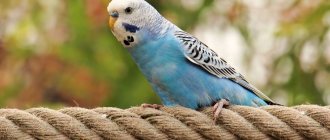When does this happen
People who breed these animals often hear a clicking or creaking sound that the birds make. It is easy to determine that they produce it with a specific movement of the beak.
Most often, parrots will fasten their beaks after eating. They can also grind in their sleep in order to sharpen their beak, since this is how they get their food. During the procedure, they sleep fully.
The cockatiel has a receding hairline above the cere.
From: Elena Tel.: 92633
Message: Good afternoon! We have a female Corella parrot, she is 1 year 10 months old. She developed a receding hairline above the cere (photo attached). Tell me, please, what could be the reason? how to solve a problem? maybe you need vitamins? We feed Podavan naturalmix, we give him carrots, green lettuce, and apples every day. Walnuts not every day, dried watermelon/melon seeds. There is a mineral stone in the cage. He drinks filtered water. Thank you in advance.
Good afternoon Problem in the respiratory system. Your cockatiel should be given the drug rhinbronchus, 10 grains per drinker, for 1 month, and then apterin, 10 grains per drinker, for 1 month. Sincerely, Vladimir Romanov
Corella in a cage
Causes
There are many reasons why parrots creak their beaks; they can both positively and negatively affect the animal’s life. If none of the reasons described below are considered appropriate for your case, it would be best to consult a veterinarian.
Mood and emotions
Like many animals, pet birds can experience emotions. Most often, your pet will clasp or click its beak because now it is happy and experiencing positive emotions. You can accurately determine that this particular reason plays a role in your case by carefully observing the parrot.
When he makes characteristic sounds after eating, playing or communicating with his owner, they can be compared to the purring of a cat that feels great where it lives.
Hygiene and nutrition
Among other reasons why a parrot clicks its beak, it may also be related to hygiene and nutrition. As already described above, they most often start this after eating. This is how they clean their beaks from food debris and other contaminants.
For these animals, it is very important to follow all hygiene procedures and monitor their own cleanliness. Does your pet not clean its feathers or beak? Most likely he is sick or depressed.
It is also very important to monitor the animal’s diet; it should be complete and varied. It is not recommended to give your parrot anything from the human table. The best food for him is various seeds and plants.
Health problems
When your pet bird never makes clicking sounds using its beak, behaves passively, is aggressive towards you, most likely, it feels very uncomfortable in your home, does not receive proper care, care, also indicates that, Most likely, he is depressed, depressed. In this case, it is better for you to contact a specialist for advice on how to change your pet’s living conditions.
Most often, these animals experience discomfort when living inside an unfurnished or too small cage, malnutrition, poor nutrition, or lack of attention.
Parrots are social birds; communication is extremely important for them. When a pet lives alone inside a cage and does not receive proper attention from its owner, it experiences loneliness.
When a bird clicks its beak and behaves aggressively, it most likely has health problems. If your parrot is breathing with its beak open, it may have a serious lung condition.
But on the other hand, very often the grinding of the beak is a sign of recovery for veterinarians. When a pet is undergoing long-term treatment, most often as soon as he begins to feel well, he makes such sounds.
Pathology or normal?
We hasten to please you - there is nothing dangerous in such a phenomenon. This is not only normal, it is also good. If a parrot creaks its beak, this in no way indicates illness. This is not a pathology, nor any other unpleasant processes.
Quite the opposite - this action on the part of the wavy demonstrates that he is completely satisfied with what is happening. When compared with the behavior of other animals, the clicking of the beak is something similar to the purring of a cat. A parrot creaking with its beak makes it clear that everything suits it, including the person it perceives as part of the flock.
A parrot creaking its beak shows that it is completely satisfied
If you hear your pet's beak clicking, this is a big plus for you. This means that you feed him correctly, take proper care of him, and he has everything in his cage for a comfortable stay. We must not forget that budgies are very emotional by nature. If they are not satisfied with something, it will immediately affect their activity, and may even lead to depression. Prolonged depression sometimes leads to the premature death of a bird - so draw your own conclusions.
There is a popular story on the Internet about how one ornithologist wrote on a forum that the creaking of its beak is the best sound for him, since in this way the bird lets him know that it is healthy again. Now it’s difficult to say whether this was an ordinary virtual parable or not, but in any case, the fact that this is an absolutely normal and even useful phenomenon is one hundred percent true.
Treatment methods
With the variety of diseases faced by cockatiels, budgies and others, there are also many treatment options available. If you want to help your pet yourself, then refer to the following methods.
- When you have a cold, you need to increase the temperature inside the animal's cage. This can be done by covering it with a towel or placing a warm lamp near it.
- If the bird is poisoned, an activated carbon solution will help. Give using a syringe without a needle; this must be done carefully so that the parrot does not choke. Usually from 4 to 6 drops 3 times throughout the day.
- If you are dehydrated, you can add glucose to food and water; it will help the liver function, which prevents intoxication of the body.
- If a bird pulls out its feathers, then you should ventilate the room more often, place the cage in a more sunny place, but avoid cooling and overheating.
- When there is no chalk or mineral stone sharpener in the cage, the pet may grow too long a beak and claws. This causes him great discomfort.
- In case of poisoning, the symptoms of which may be diarrhea and vomiting, a solution of glucose or citrus juice also helps.
General impression
Corella parrots are friendly and trusting birds. However, without constant communication with the owner, the cockatiel can quickly turn into a wild parrot, responding with aggression to any human movement. After all, these are very proud birds that do not tolerate disdain for their person.
Cockatiels can become devoted companions who fall in love with their owner. But the parrot will reciprocate only if you give your pet daily attention, take care of it, play, and periodically let it out of the cage. And then you will be able to feel how they amusingly finger the hair on your head as a sign of their fidelity and boundless love.
Only by respecting the cockatiel and satisfying his personal needs can you buy an affectionate pet that will greet you with joyful cries every time. Of course, not all birds are the same; each has its own personality and preferences. But in general, these parrots are pleasant birds to talk to.
Let's take a closer look at some of the behavioral features of these parrots.
How to teach a parrot to creak its beak
Since feathered pets most often click because of a feeling of pleasure, every loving owner would like to hear this sound more often.
In order to achieve this, you need to monitor the welfare of the bird.
- The cage should be spacious, the size depends on the breed and the number of animals inside it. It is best to choose natural materials, as plastic can be harmful to health.
- Inside the habitat, in addition to the feeder and saw, there must be perches, swings, baths, sand and a variety of toys. The best toys for animals are those that have a rough surface.
- A healthy diet should be formed from plant seeds, greens and mineral supplements, avoiding human food in the diet.
- Communicate and play with your parrot more often, as they need to feel completely healthy and happy. They are one of the most social creatures.
Traditional plastic carrier
Perhaps the most common way to move small animals. Very well suited for long-distance travel, but in a car (and especially on a bicycle) a bulky plastic box is not very convenient.
Among the advantages, we note excellent breathability, ease of cleaning and maintenance, the ability to organize meals while traveling, hygiene, strength and durability.
The disadvantages are determined by the need to allocate space for storing this box and, of course, the outdated design. It is necessary to have such a device in stock, but it is not very suitable for short-term forays outside the city.
Cost – 1,146 – 2,137 rubles.
Why does a parrot cock its feathers?
If a restless budgie has stopped jumping and twittering and sits more and more, with its ruffles and head hidden, this behavior is an alarming signal. This is not always a symptom of illness, but it is obvious that the parrot is cresting due to severe discomfort. In addition to the disheveled appearance, the bird develops a slight chill. She rolls her eyes and opens her beak, breathing heavily. The reasons for such poor health are hidden in the increase in body temperature, which indicates inflammatory processes in the body.
Cold
Delicate ornamental birds are afraid of drafts; even a light summer breeze is harmful to them. A cold is manifested by sneezing, runny nose, and later a cough. The parrot refuses food and sits for a long time, huddled in a ball and with its feathers spread out. Thus, he tries to conserve energy and keep warm. How to help, how to treat if a parrot has been cresting for several days?
First aid:
- Humidify the air. Increased dryness harms the respiratory system, the condition of the bird worsens;
- Let's drink a warm infusion of chamomile with a drop of lemon juice. This drink relieves inflammation and strengthens the immune system;
- Use steam inhalation. Pour crushed chamomile flowers with hot water and place the container near the cage. By inhaling healing air, the bird will stop coughing faster.
If the above methods do not help within one to two days, contact your veterinarian. After a medical examination, it will be clear why the ruffled parrot looks so sick. Perhaps his illness has a more serious origin than a cold.
Internal parasites
Consider this situation: a parrot hides its head under its wing and sleepily ruffles its feathers, although it is still light. He reacts irritably to touch and does not respond to the owner’s voice; he descends onto the tray of the cage, unable to stay on the perch. Most likely, the pet has helminths inside, which take away energy. Intestinal parasites are not uncommon in pets. Helminthiasis greatly complicates the life of birds, and they become infected by eating dirty food. Poor sanitary conditions, lack of disinfection of equipment - and roundworms are right there.
Parasites annoy the bird so much that it has no desire to preen itself. Feathers are constantly ruffled; now tasty food is not a pleasure for the budgerigar. An apathetic attitude, silence and weakness make the pet unrecognizable. Treatment will help restore the joy of life to a parrot that has become ruffled. It is quite difficult to detect helminths on your own, so you need to get tested at a veterinary clinic. There are drugs available that quickly get rid of parasites.
Poisoning
It's no secret that parrots love to taste everything around them. Flying around the room, a bird can bite off a leaf of a plant, swallow a piece of newspaper, or steal a pill forgotten on the table. The outcome of such incidents is not always successful. After a free walk, the parrot sits quietly at the bottom of the cage, exhausted, indifferent to everything. Look around, perhaps you will notice some clue as to why the parrot is ruffled.
What can poison a domestic wavy?
- medicines;
- poisonous paint or flowers;
- toxic aerosol;
- resin;
- food from the common table;
- low quality plastic.
Exhausted, lethargic and chilly, why does a parrot become like this? If the pet also suffers from vomiting and diarrhea, we can talk about poisoning with spoiled food. Damp grain left in the feeder quickly becomes moldy. Unripe or rotten fruits cause fermentation in the stomach. Mild intestinal upset usually resolves within a few days.
What could cause the symptom?
The reasons for clicking can be different:
- cleaning the teeth after eating (parrots are very clean birds and constantly carry out hygiene procedures - cleaning feathers, claws and beak);
- self-sharpening of the beak by grinding and clicking (you can hear a characteristic grinding sound);
- emotions of happiness and joy that a pet expresses to its owner (for example, after an active flight or playful communication);
- diseases.
IMPORTANT! If the parrot breathes frequently and clicks its beak, while the bird's activity has decreased, a viral infection is suspected. You should immediately contact your veterinarian to clarify the diagnosis, take tests, and prescribe the necessary treatment.
Sexual behavior
In this case, the parrot groans when a member of the opposite sex is next to it. At the same time, other behavioral features are observed: the bird can arch its back, shake its tail or squat. This is normal and indicates that the feathered pet is in good health.
The parrot grunts especially actively during the mating season. At this time, other rituals are observed in the couple: birds preen each other’s feathers, lightly pinch their partner, they can kiss and feed their dear friend. If suitable conditions are created for exotic pets at this time, they will begin to reproduce.
Sometimes sexual behavior with grunting occurs when there are no other parrots nearby, but a human is nearby. This is considered a violation of the bird's mental state. It is necessary to adjust the behavior of the winged friend. It is necessary to give the bird the opportunity to often fly around the room, load it with physical activity and conduct developmental activities. Let the parrot play with its toys and nibble on vegetables or fruits.
Simple wire cutters
The most primitive device is very similar to ordinary scissors. Only one of its cutting surfaces is equipped with a small notch with a sharp edge. Using such a device is easy, provided you have some skill and experience. For young dogs, nail trimming is always stressful. They do not want to sit quietly, they strive to tear the paw out of the owner’s hands and in every possible way complicate the process. So Litbro.ru will not recommend such a gadget to novice dog breeders. The risk of causing serious physical injury to your pet is too great. Well, for experienced owners who have used similar tools more than once, nothing better can be desired. Cheap and very effective.
Cost – 35 – 72 rubles.
More advanced versions of hand cutters offer expanded functionality.
Although their main part, in the old fashioned way, is based on two cutting surfaces. Service additions imply only human convenience. Models with rounded ends, a container for cut claws and lighting have proven themselves very well. The fact is that some dogs have the habit of looking for clipped ends on the floor and eating them. Sharp, bent cuttings can damage the stomach wall and cause bleeding. A small “waste collection” effectively solves this problem.
Price – 636 rub.
Another gadget from the line of simple nippers has comfortable ergonomic handles that allow you to securely hold the tool while trimming nails.
This is important when the animal gets nervous and breaks out.
We pay attention to one more detail - the expansion spring. It fixes the cutting surfaces in the open state, which makes the operation somewhat easier.
Otherwise, the functions of the device duplicate all the features of its predecessors. To properly shorten claws, you must have the skill and achieve unquestioning obedience from your dog or cat.
Cost – 229.93 rubles.
